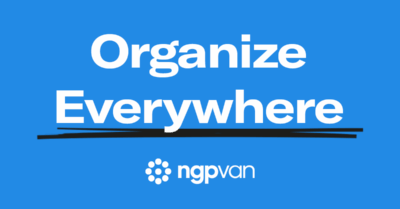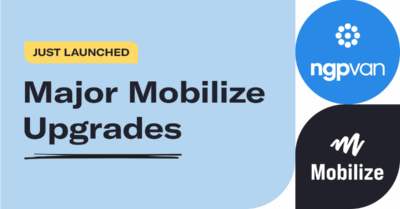How to Canvass for A Political Campaign: The Basics + 7 Tips

Political campaign managers, field directors, and field organizers are in charge of developing and executing a field strategy to promote awareness of their candidate and persuade voters to support the campaign. And most importantly, these campaign staffers are in charge of mobilizing enough voters to get out and vote to win the election. Through political canvassing, campaign volunteers and staff can meet with voters one-on-one to introduce their candidate, talk about the issues, and secure support for the campaign.
Campaign canvassing has evolved thanks to advances in advocacy software and new insights into campaigning best practices. To help your Democratic or progressive candidate get elected, this blog will walk through the essentials of canvassing before diving into seven helpful tips to improve your canvassing campaigns.
How Does Canvassing Work?
Canvassing is the practice of contacting voters by going door-to-door in a given area to promote your campaign’s candidate. However, campaign managers who have run canvassing initiatives before know the actual strategies involved go far beyond this definition. Staff need to create targeted lists of voters, cut those lists into turfs (geographic areas with a set number of voters within them), coordinate a canvass launch and recruit volunteers, and finally distribute those turfs to volunteers who will then go out and knock doors. Now that we’ve described how canvassing works generally, let’s describe the different types of canvassing campaigns can employ.
Political Canvassing
If you’re canvassing for a candidate for an upcoming election, your organization is conducting political canvassing. Political canvassing involves surveying voters to ask about their voting plans for upcoming elections, spreading awareness about your candidate, and persuading undecided individuals to vote for your candidate.
Additionally, canvassing is an information-gathering strategy that can help your campaign gain a stronger understanding of your district’s political leanings and the issues they care about. Canvassing is also a critical component of Get Out The Vote (GOTV) efforts, especially for early voting initiatives. While political canvassing (sometimes just called canvassing or traditional canvassing) has been a staple practice of community organizing, two other types of canvassing have recently arisen as potential alternatives to more effectively contact and connect with voters.
Distributed Canvassing
In a traditional canvassing campaign, field organizers are responsible for managing volunteers, cutting turf, and generally overseeing canvassing operations. However, a highly centralized approach is not always practical for canvassing initiatives, especially in large districts and statewide elections.
To reach more voters, some campaigns turn to distributed canvassing, a method wherein groups of volunteers manage themselves to canvass their local communities while still receiving guidance and support from the campaign. Similarly to traditional political canvassing, the focus of distributed canvassing is gathering information quickly with a defined script and survey questions. However, rather than organizing through a centralized campaign, volunteers organize themselves independently and they begin outreach on behalf of the campaign on their own time.
Distributed canvassing can be improved through the use of canvassing software that allows campaigns to cut and distribute turf with a script to volunteers. Volunteers can then canvass on their own time and the campaign can monitor progress on those turfs and advance towards their voter contact goals. Some campaigns find this to be extremely effective, while others worry about relinquishing some level of control over their canvassing efforts.
Deep Canvassing
Traditional political canvassing strategies focus on sharing the campaign’s message with voters, usually through a quick 60-second elevator pitch followed by a series of questions to gather more information about whether they plan to support the campaign. This approach is useful for building awareness about the campaign and gathering more data to act on later in the election cycle.
However, many campaigns have found it’s more persuasive to have longer, more in-depth conversations about the issues relevant to voters. This approach is called deep canvassing, and it’s especially useful for building connections with voters who may otherwise be undecided about a candidate or unsure how they feel about a specific issue.
For deep canvassing, encourage volunteers to take their time at each door, asking open-ended questions that invite voters to share their thoughts on the issues. Direct them to use active listening and make an effort to find common values with each voter, while not being afraid to ask the tough questions if a situation calls for it.
Deep canvassing leverages the power of letting voters persuade themselves. Rather than telling voters what to think, this strategy focuses on having conversations and asking questions that cause voters to more deeply consider the reasons behind their beliefs and which candidate best represents their interests. However, deep canvassing also requires more time at each voter’s door, which can slow your overall voter contact efforts unless you increase the number of volunteers who are knocking doors and talking to voters.
How Effective is Canvassing?
Despite a growing shift towards digital outreach, canvassing is still an effective method for reaching voters, especially those who are less likely to be reached online or on the phone.
Here are a few ways canvassing can benefit your campaign:
Builds Connections
In-person conversations help your campaign build a rapport with voters that is hard to replicate online. Canvassing can be especially effective at this if you assign volunteers to canvass their own communities. Voters may be more receptive to questions asked by a neighbor or community member they see regularly.
Persuade Undecided Voters
Canvassing is an opportunity to have productive conversations with voters and directly answer their questions or discuss important topics. Give your volunteers the tools and information they need to talk about these topics so they can help provide voters with explanations about why your candidate’s approach to various issues benefits them.
Encourages Voting
Some people may need more information before they go and cast their ballots. GOTV canvassing efforts are focused on driving likely and identified supporters to get out and vote. Most of these efforts will share important voting information (like the nearest polling location) and encourage supporters to vote early if they can. This extra push can be the difference needed to stir your candidate’s base to action.
Of course, the effectiveness of your canvassing efforts depends on your approach, what you’re talking about, and who you’re talking to. The strategies that work for each group of voters will likely vary based on their current views, motivation to vote, and even their mood when approached by a volunteer.
7 Political Campaign Canvassing Tips
Ultimately, your campaign knows how to best approach your community based on the information your team has gathered by listening to voters, conducting polls, and just living in local neighborhoods. However, there are a few canvassing tips that can be helpful for almost every campaign.
1. Follow Local Canvassing Laws
Research laws related to canvassing in your state and city. In most places, the general regulations that apply to canvassing are:
No Trespassing & No Soliciting Signs
While you may be able to approach homes with “No Soliciting” signs, the residents of those homes may not be interested in speaking with unexpected visitors. Make sure to check with your local authorities and prioritize your own safety at all times.
Political Campaign Literature & Materials
Do not put campaign literature or other materials in mailboxes. Instead, leave campaign materials on doorknobs or other easy-to-spot locations for voters who were not home.
Volunteer Identification
Have volunteers carry identification that they are canvassing for a political candidate. Police officers or unsuspecting homeowners may stop canvassers if they are unsure what they are doing or are unfamiliar with canvassing laws. Help your volunteers avoid any issues that may arise by providing clear identification that marks them as canvassers. However, advise canvassers to leave the situation if it becomes too tense and contact the campaign to let them know what happened.
Before your canvassing initiatives, be sure to go over these and other canvassing-related laws with all volunteers. Doing so can save your campaign from getting fined and make sure your volunteers have a trouble-free canvassing experience.
2. Determine How to Use Turf-Cutting Software
Cutting turf can easily be one of your field organizers’ most time-consuming responsibilities. However, it’s also one of the most important tasks to execute effective voter outreach. Every campaign will need to determine how they want to use turf-cutting software. They’ll need to decide if they want to cut turfs manually or automatically in a specific area or use something like Distributed Contacts Campaigns in VAN (which automatically cuts turfs based on your canvasser’s location).
Some campaigns manually cut their turf to be more precise and consider additional geographic features (e.g., busy roads, large bodies of water, etc.). However, turfs that are cut automatically can be more efficient for some campaigns that may need a large number of turfs with a specific number of voters in them. With Distributed Contacts Campaigns, once the volunteer enters the list number in MiniVAN, it automatically cuts a turf of a preset number of voters closest to the volunteer.
It’s ultimately up to your campaign to determine how to best use your turf-cutting software, but all these strategies will help you conduct more targeted outreach at voters’ homes.
3. Onboard Your Volunteers
Volunteers will have more productive conversations with voters if they receive proper canvassing training ahead of time. Ensure your volunteers make the best impression on voters possible by hosting onboarding meetings where you prepare them by:
- Reviewing key issues and talking points
- Going over standard canvassing procedures
- Teaching them how to use any necessary tools, such as canvassing software
- Informing them of local canvassing laws
- Answering questions
For remote groups of volunteers, host online onboarding sessions where volunteers can meet with a field organizer remotely. You should also prepare online versions of canvassing materials, such as volunteer handbooks and information sheets about local voting registration laws. You may need to give them campaign literature or other materials, so figure out the best way to deliver those materials so they can start canvassing right away.
4. Focus On the Voters You Need to Win
When creating your field plan, consider what voters you need to focus on to reach your candidate’s win number. This number is unique for each campaign, and the path to your win number is also different for each campaign. However, for many campaigns, reaching your win number will focus on two groups:
Undecided Voters Who are Likely to Vote
These are the swing voters who often determine the results of elections. Making personal connections with these voters and showing them how your candidate’s policies benefit them can help gain enough support to win your election.
Democratic Voters Who Sometimes Vote
Voters who are already likely or identified supporters of your candidate’s party don’t need to be persuaded to agree with your candidate, but they may need something to motivate them to vote. For these voters, run GOTV initiatives that emphasize the importance of this election, how close the race is likely to be, and how they can vote early and conveniently.
How you divide your resources between these groups and others depends on the political makeup of your district. Past election data and initial canvassing efforts earlier in the campaign cycle can help you determine which groups of voters to focus on and how that will impact your canvassing strategy. Ultimately, it’s up to your campaign to create your win number and determine how to achieve it.
5. Prepare Branched Scripts
Consider the topics voters may bring up and prepare your canvassing team to discuss them with branched scripts. Branched scripts help guide canvassing conversations and automatically adjust based on voters’ responses to your survey questions.
Using canvassing software helps your volunteers quickly navigate through the script rather than needing to sort through a paper script. It also helps conversations flow more naturally and avoids awkward pauses.
6. Thank Everyone You Talk To
Whether a conversation ends in a pledge to vote for your candidate or your volunteers are turned away early, be sure to show appreciation to everyone you interact with while canvassing. Your volunteers’ behavior reflects on your candidate, and being respectful and polite even to difficult voters creates a positive impression of your campaign.
7. Prioritize Volunteers’ Health and Safety
Volunteer health and safety are paramount considerations on any campaign. The weather, especially with the increasing occurrence of record-breaking heat waves and severe weather in recent years, can significantly impact your team’s ability to reach targeted voters. Consequently, ensuring your volunteers remain healthy and safe amidst harsh weather conditions becomes crucial.
Aside from weather-related concerns, it is equally important to address personal safety measures to ensure volunteers always feel secure and at ease while engaging in door-to-door canvassing. By taking proactive steps, you can create a conducive environment that promotes the well-being of your volunteers.
To achieve this, here are a few essential tips to keep your volunteers healthy and safe while canvassing!
Prepare for Adverse Weather Conditions
While canvassing is important, encourage your volunteers to prioritize their health and safety first. If they need a break to sit in the shade or fill up their water bottle on a hot day, ensure they know they are more than welcome to take it. Similarly, if severe weather moves into the area, encourage your volunteers to prioritize their safety and contact the campaign if they cannot finish their shift or turf.
Additionally, staying hydrated is one of the most important ways to do keep your volunteers cool and healthy (especially in the summer). Encourage volunteers to carry water bottles with them or even provide water bottles at your staging location.
Canvass Early in the Day & Evening
Start canvassing early in the day before the day heats up too much. Canvassing early in the day on weekends and in the early evenings during the week typically helps avoid the hottest parts of the day. It may also increase your chances of speaking to more voters as they’re more likely to be home during those times.
Knock on Doors in Pairs
Canvass launches usually start by pairing up canvassers to head out on the doors. While canvassers will typically knock on opposite sides of the street, pairing up volunteers initially ensures that there is someone nearby in case a situation arises if one volunteer needs extra support. Instruct canvassers to also stay within eyesight of one another as well to help safely move through their turf together.
Stay Outside & Leave Uncomfortable Situations
Occasionally, voters may invite canvassers inside their homes. It’s best to remain outside and have a conversation on the porch or doorstep. While it’s unlikely that there is any malicious intent, it’s a risk that can be mitigated by just staying outside. Similarly, if there is ever a conversation or situation that arises in which a canvasser starts feeling uncomfortable or unsafe, encourage them to quickly thank the voter and move to the next door, connect with their canvassing partner, or contact the campaign.
By following these tips, you’ll prioritize your volunteers’ health and safety and create a better canvassing experience for your volunteers.
Campaign Canvassing with NGP VAN
Canvassing is a core campaigning strategy, allowing your team to reach more voters, build connections, and get commitment from the voters you need to reach your campaign’s win number.
Supercharge your campaign canvassing efforts by investing in campaign management software. Learn how our tools can help you contact more voters, track canvassing progress, and more.



